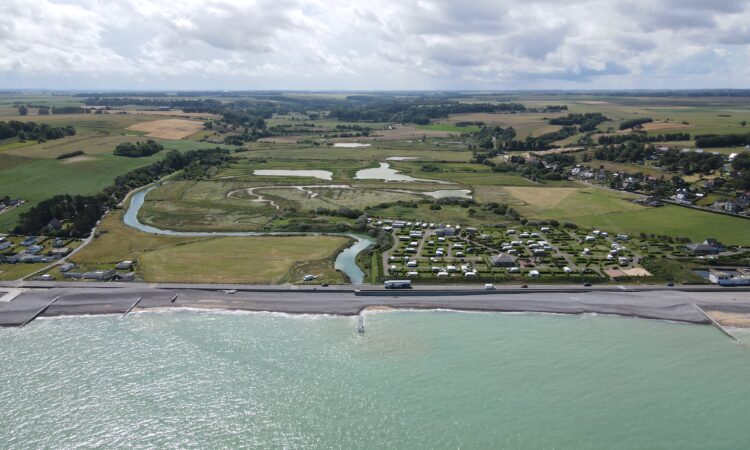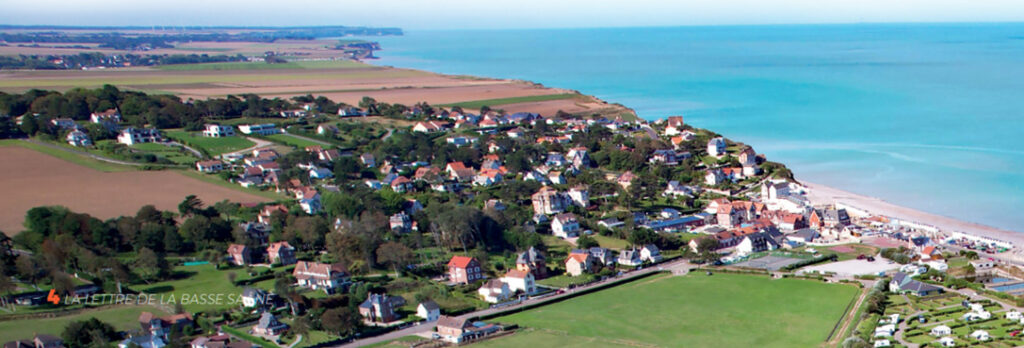
Several players share the task of buying the land needed for the component parts of the project, according to their particular responsibilities.
Increasing connectivity between the Saâne River and its floodplain; reconnecting it to the sea; moving the Quiberville municipal campsite and the Sainte-Marguerite-sur-mer bungalows; building a wastewater treatment plant in Longueil; restoring biodiversity.
All of these elements, which form the backbone of the Basse Saâne 2050 project, first require securing ownership of the land concerned. Indeed, having excavators move in on land that does not belong to you is more than just bad manners!
“Land acquisition” is therefore a key part of the Basse Saâne project. It has been carried out by several players which have their own specific rules, methods and responsibilities: the Conservatoire du littoral, the Établissement public foncier de Normandie (EPFN), the Société d’aménagement foncier et d’établissement rural (SAFER) and, of course, the local municipalities involved and the Terroir de Caux Community of Municipalities.

• The Société d’aménagement foncier et d’établissement rural (SAFER) of Normandy
This is a non-profit joint-stock company with general interest missions, placed under the supervision of the French Ministries of Agriculture and Finance. It operates in the rural land market across France, buying agricultural and rural properties to allocate to private or public applicants whose projects contribute to the implementation of local sustainable development policies. For the Lower Saâne 2050 project, it is therefore the SAFER that is tasked with acquiring all the agricultural land needed to bring it to fruition. Some of this land will then be transferred to the Conservatoire du littoral, thus becoming the inalienable property of the Conservatoire which will then be able to return it to its agricultural use. (Keep reading, it will all make sense in the end!)
• The Établissement public foncier de Normandie (EPFN)
This organisation’s purpose is to acquire land for the development by a third party of housing, new neighbourhoods or public amenities. This strategic acquisition involves transitory land ownership. For a certain time, the EPFN owns and manages the plot of land (security, etc.). Sometimes, it may prepare the site (demolishing existing buildings, cleaning up, etc.) before selling it on to a local authority. In the case of the new tourist facility, the landowner is now the municipality of Quiberville. However, the EPFN’s know-how has been invaluable in optimising the site, consolidating the plots, advising the municipality on its land strategy and supporting the demolition and ecological restoration of the existing campsite.
• The Conservatoire du littoral
The Conservatoire du littoral coordinates the Lower Saâne 2050 project and has been active in the valley since 2006. Its mission is to acquire land in coastal areas to protect it from land speculation and development. Once acquired, it becomes “inalienable” public property: the Conservatoire du littoral cannot resell it and must entrust its management to a third-party, usually the municipality or the department: here as the project area covers a sensitive natural area, the department of Seine-Maritime. The Conservatoire has acquired land in the lower valley, as in other coastal valleys in Normandy. In 2018, it extended its operational scope to the land bordering the Saâne River, with the approval of the various municipalities. The articles of the Conservatoire du littoral however prevent it from buying land to build, for example, a new tourist facility, since it must protect the sites it acquires from further development. This is why the plot of land for the new campsite was bought by the EPFN.
• The Terroir de Caux community of municipalities
This local authority acquired the land on which the Longueil wastewater treatment plant was built.
All these players have different roles to play. But all face an implacable rule: they can only buy a piece of land… if the owner agrees to sell it! Once a project is adopted, it may sometimes take a long time before it is implemented. “In a land negotiation, the key to success is patience,” explains Elodie Agard, in charge of land management at the Normandy branch of the Conservatoire du Littoral. “When a landowner refuses to sell and however good your arguments are, you won’t get anywhere”. Of course, the SAFER and the Conservatoire du littoral have a secret weapon: the right of first refusal. When a sale is planned, the notary notifies the operation by issuing a “declaration of intention of alienation” and under certain conditions the public operators can buy the land themselves by ousting the original buyer. Sometimes renegotiating the price. But in this case, the seller can always decide not to sell!




